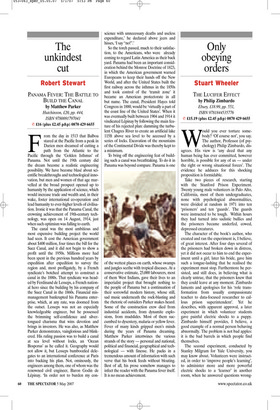The unkindest cut
Robert Stewart
PANAMA FEVER: THE BATTLE TO BUILD THE CANAL by Matthew Parker Hutchinson, £20, pp. 444, ISBN 9780091797041 ✆ £16 (plus £2.45 p&p) 0870 429 6655 From the day in 1513 that Balboa stared at the Pacific from a peak in Darien men dreamed of cutting a path from the Atlantic to the Pacific through the ‘Golden Isthmus’ of Panama. Not until the 19th century did the dream become a realistic engineering possibility. We have become blasé about scientific breakthroughs and technological innovation, but men and women of that age marvelled at the broad prospect opened up to humanity by the application of science, which would increase trade and wealth and, in their wake, foster international co-operation and lead humanity to ever-higher levels of civilisation. Ironic it was that the Panama Canal, the crowning achievement of 19th-century technology, was open on 14 August, 1914, just when such optimism was falling to earth.
The canal was the most ambitious and most expensive building project the world had seen. It cost the American government about $400 million, four times the bill for the Suez Canal, and it did not begin to show a profit until the 1950s. Millions more had been spent in the previous hundred years by expedition after expedition to survey the region and, most profligately, by a French syndicate’s botched attempt to construct a canal in the 1880s. That syndicate was headed by Ferdinand de Lesseps, a French national hero since the building by his company of the Suez Canal in the 1860s. Financial mismanagement bankrupted his Panama enterprise, which, at any rate, was doomed from the outset. Lesseps was not an especially knowledgeable engineer, but he possessed the brimming self-confidence and silvertongued charisma that wins devotion and brings in investors. He was also, as Matthew Parker demonstrates, vainglorious and blinkered. His ruling passion was to build a canal at sea level without locks, an ‘Ocean Bosporus’ as he called it. Geography would not allow it, but Lesseps bamboozled delegates to an international conference at Paris into backing his plan. Not, ominously, the engineers among them, one of whom was the renowned civil engineer, Baron Godin de Lépinay. ‘In order not to burden my con science with unnecessary deaths and useless expenditure,’ he declared above jeers and hisses, ‘I say “no!”.’ So the torch passed, much to their satisfaction, to the Americans, who were already coming to regard Latin America as their back yard. Panama had been an important consideration behind the Monroe Doctrine of 1823, in which the American government warned Europeans to keep their hands off the New World, and after the United States built the first railway across the isthmus in the 1850s and took control of the ‘transit zone’ it became an American protectorate in all but name. The canal, President Hayes told Congress in 1880, would be ‘virtually a part of the coast line of the United States’. When it was eventually built between 1904 and 1914 it vindicated Lépinay by following the main feature of his rejected plan: damming the turbulent Chagres River to create an artificial lake 115ft above sea level to be accessed by a series of locks. Excavation of the mountains of the Continental Divide was thereby kept to a minimum.
To bring off the engineering feat of building such a canal was breathtaking. To do it in Panama was beyond compare. Panama is one of the wettest places on earth, whose swamps and jungles seethe with tropical diseases. At a conservative estimate, 25,000 labourers, most of them West Indians, gave their lives to an imperialist project that brought nothing to the people of Panama but a continuation of their sorrowful modern history, whose still, sad music underneath the rock-blasting and the rhetoric of outsiders Parker makes heard. Some of the construction crew died from industrial accidents, from dynamite explosions, from mudslides. Most of them succumbed to dysentery, malaria or yellow fever. Fever of many kinds gripped men’s minds during the years of Panama dreaming. Matthew Parker intertwines the various strands of the story — personal and national, political and financial, geographical and technological — with finesse. He packs in a tremendous amount of information with such verve that his book feeds without bloating. Best of all, his prose somehow manages to infect the reader with the Panama fever itself. It is no mean achievement.


































































































 Previous page
Previous page